#lactarius fungus
Explore tagged Tumblr posts
Text

indigo milk cap (lactarius indigo)
note!! please do not pick and eat mushrooms by yourself! it is very easy to pick up the wrong mushroom and I could be poisonous!
the indigo milk cap is a bright blue colored mushroom that grows throughout north america, east asia, france, and central america.
this mushroom is edible. it has a bitter almost peppery taste to it, and the flesh of this mushroom is also very firm.
common places for this mushroom can be found are: gulf of mexico's coast, mexico, guatemala, along the appalachian mountain range, arizona, california, virginia, (one county in) texas, china, india, costa rica, and south france.
the indigo milk cap has a depressed cap, pretty tightly pack gills, and a square shaped stem. the flesh is also blue and once exposed to air for awhile will turn a greenish color. and the milk of the indigo milk cap tried a greenish color.
in early stages of life the indigo milk cap is wet and slimy but grow dry and brittle once the mushroom is established and older.
#mushrooms#mushroom#mycology#indigo milk cap mushroom#fungi#fungus#lactarius#lactarius mushroom#lactarius fungi#lactarius fungus#lactarius indigo#lactarius indigo mushroom#lactarius indigo fungi#lactarius indigo fungus#indigo milk cap fungi#indigo milk cap#indigo milk cap fungus#milk caps#milk cap#milk cap mushroom#milk cap mushrooms#milk cap fungi#milk cap fungus#indigo milk cap mushrooms#lactarius mushrooms#lactarius indigo mushrooms
6 notes
·
View notes
Text
Lactarius indigo
also known as the indigo milk cap, the blue milk mushroom and indigo milky.
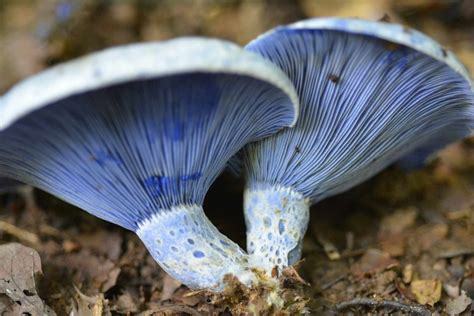


It grows in North America, East Asia, and Central America. It also grows naturally in southern France!
Due to being a member of the lactarius genus it produces latex or “milk” when cut. The latex produced is indigo hence the name.
The species is however noted for not producing as much latex as other members of its genus.



Lactarius indigo is edible and reported to have a mild taste.
It is also one of my favourite mushrooms!
#Soupandmushrooms#mushrooms#fungus#fungi#lactarius indigo#lactarius genus#Hiiiii i got a mushroom blog to fule the hyperfocus
303 notes
·
View notes
Text
Indigo Milk Cap Mushroom
Lactarius indigo
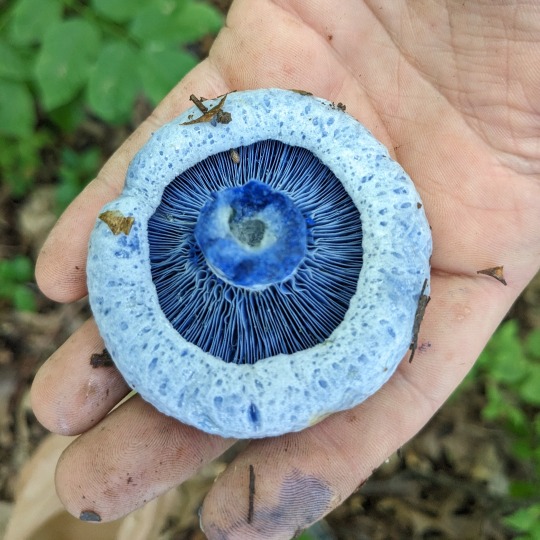


These otherworldly deep indigo blue milkcaps contain a derivative of azulene. This pigment is also found in some species of soft corals throughout the oceans.



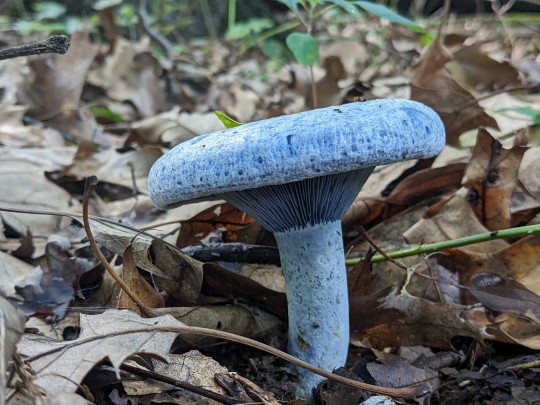
Edible (at your own risk). They have a mild taste to me and I prefer them sauteed.
Aug. 14th, 2023
St. Louis County, Missouri, USA
Olivia R. Myers
@oliviarosaline
#mushrooms#mycology#nature#beautiful nature#blue mushroom#indigomilkcap#milkcap mushroom#indigo milkcap#foraging#interesting nature#interesting#blue mushrooms#lactarius indigo#milk cap mushrooms#exploring nature#exploring the woods#exploring#discovering nature#mushies#mushroom#beautiful mushrooms#fungi#wild fungi#fungus#cottagecore#foraged food#fungi photography#mushroom photography#forestcore#russulaceae
37 notes
·
View notes
Text



I led a lovely afternoon guided nature tour at the Cutthroat Climb and Teal Slough trails at Willapa National Wildlife Refuge! It was a nice break from the mayhem of packing the moving truck with my furniture and whatever else we can fit in there. There's still a lot to be done, but we're making good progress, and will haul things to Portland Sunday. Wish us luck!
Also, I'd love to make some plans for some tours once I get settled in in PDX, so if you've been wanting to book me for a private tour, drop me a PM!
#nature#forest#old growth forest#western red cedar#Lactarius#rattlesnake orchid#orchids#mushrooms#fungus#fungi#PNW#pacific northwest#native plants
19 notes
·
View notes
Note
Lactarius indigo?
FOTD #036 : indigo milky! (lactarius indigo)
the indigo milky (also called blue lactarius, indigo milk cap or blue milk mushroom) is a mycorrhizal mushroom in the family russulaceae. this mushroom is found across the US, mexico, china, india, costa rica & guatemala. it is famous for its blue, milk-like latex that seeps out when the gills are sliced !!
the big question : can i bite it?? yeah<3 this fungus is edible.

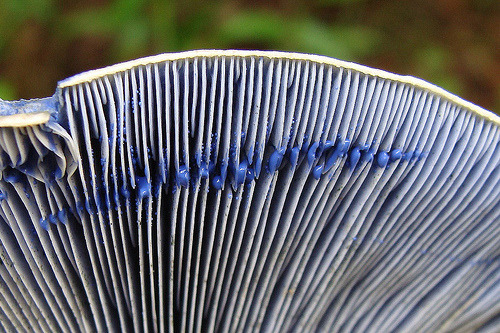

l. indigo description :
"the cap of the fruit body, measuring between 5–15 cm (2.0–5.9 in) in diameter, is initially convex & later develops a central depression; in age it becomes even more deeply depressed, becoming somewhat funnel-shaped as the edge of the cap lifts upward. the cap surface is indigo blue when fresh, but fades to a paler grayish- or silvery-blue, sometimes with greenish splotches. it is often zonate: marked with concentric lines that form alternating pale & darker zones, & the cap may have dark blue spots, especially towards the edge. young caps are sticky to the touch. the flesh is pallid to bluish in color, slowly turning greenish after being exposed to air; its taste is mild to slightly acrid. the flesh of the entire mushroom is brittle. the latex exuded from injured tissue is indigo blue, & stains the wounded tissue greenish."
[images : source, source & source] [fungus description : source]
"thank you for the request !! i really love this one, but will likely never seen it in person. ^^" very beautiful mushroom."
#• fungus of the day !! •#• askbox replies: •#[lactarius indigo]#: indigo milky :#: blue milk mushroom :#: indigo milk cap :#: blue lactarius :#036#||#mushroom#fungus#mycology#mushrooms#cottagecore#forestcore#nature#earth#fungi#foraging#fotd#fungus of the day#lactarius indigo#indigo milky#indigo milk cap#blue milk mushroom#blue lactarius#special interest
64 notes
·
View notes
Text
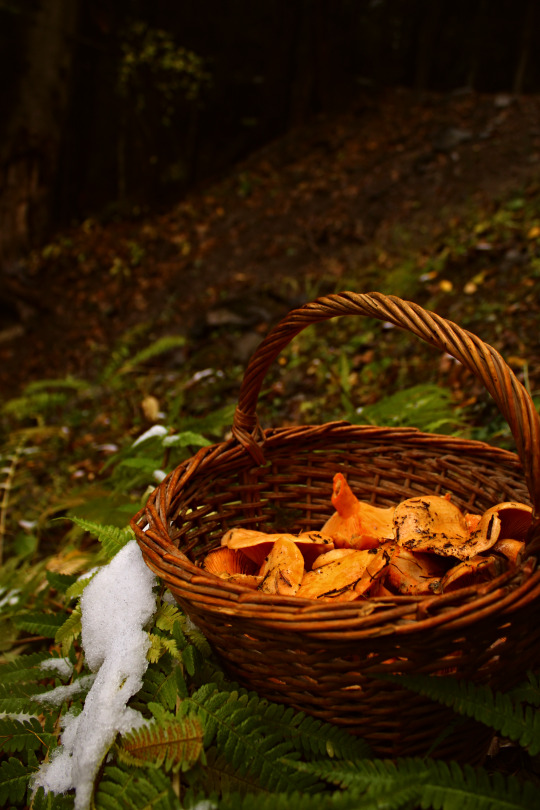
A bunch of Lactarius deliciosus among the snowy ferns.
Cooked lovely meals with those, yummy !
#mountains#forest#mushrooms#lactarius#lactariusdeliciosus#fungi#fungus#mosscore#cottagecore#mycology#forestcore#savoie#champignons#ferns
40 notes
·
View notes
Text

Reizker,dieser wohl ein Fichtenreizker,nehme ich nie zu Speisezwecken,auch wegen der sehr grossen Ähnlichkeit der bitter und scharf schmeckenden Lactarius Arten zum Edelreizker.Milchbraetlinge sollen ja gebraten eine Delikatesse sein,ich vermute aber nur wegen einer raffinierten Würzmischung des Kochs....brauch ich nicht,wenn ich Steinpilze habe ..zb.
Ebenso lasse ich die Finger von Taeubling,Russula Arten!!
Entweder sie schmecken scharf und sind leicht giftig,nur durch GeschmacksTest eines kleinen Stückes vom Pilz vorab eruierbar und nicht anhand der Hutfarbe,oder sie schmecken mild .
Aber langweilig, uninteressant! Ohne Eigengeschmack.
Dito nehme ich nie Perlpilze!
Gestern hatte ich einen sehr ähnlichen, Potentiell tödlich giftigen Pantherpilz vor mir ,leider vergessen ihn zu fotografieren.
3 notes
·
View notes
Text

milkcap (most commonly lactarius) fungi exude a white latex when they are cut or bruised.
#fungi#russula#lactarius#mushrooms#fungus#the ONLY milkcap i saw this season after finding a clutch of saffrons the year before :(
1 note
·
View note
Text

Lactarius again, probably deliciosus this time.
#Bruce Trail#Bognor Marsh#Niagara Escarpment#Bruce Peninsula#Bruce County#Ontario#Canada#hiking#hiking trail#nature#forest#trees#wilderness#outdoors#wetland#marsh#Lactarius deliciosus#mushroom#mycology#fungus#photography#digital photography#DSLR#Canon 6D#photographers on Tumblr#2022-09-03
1 note
·
View note
Text
Mushroom popularity contest gogogo
#fungi#mycology#nature#fungicore#mushroom#cottagecore#dirtcore#forestcore#forest#fungus#this is impossible to do without missing off like. most of the fungi groups out there#but it's just for fun so whatever
121 notes
·
View notes
Note
Are there particular species of trees edible mushrooms like growing near? For example, the way truffles are generally found under oak trees? (I hope I got that right!)
Yes, you are right. A symbiotic association between a fungus and a plant is called mycorrhiza. Different mushroom species will choose different trees, however, the type of soil plays a big part, too, and not every species is super picky. Some will grow under/on both deciduous and coniferous trees.
Examples:
Boletus edulis - spruce.
Boletus pinophilus - pine.
Boletus reticulatus (syn. B. aestivalis) - oak trees.
Boletus projectellus (syn. Boletellus projectellus) / Aureoboletus projectellus) - pine.
Boletus betulicola/ B.edulis var. betulicola - birch trees.
Leccinum albostipitatum - aspen.
Leccinum aurantiacum - aspen.
Leccinum versipelle (syn. L. testaceoscabrum) - birches and spruce.
Leccinum duriusculum - birches and aspen.
Leccinum vulpinum - pine.
Leccinum melaneum (syn. L. roseofractum) - birch trees.
Leccinum variicolor - birch trees.
Leccinum niveum (syn. L.holopus) - birch trees.
Leccinum crocipodium (syn. Leccinellum crocipodium) - oak trees.
Leccinum scabrum f.oxydabile - birch trees.
Leccinum aurantiacum f.quercinum - oak trees.
Suillus granulatus - pines.
Suillus luteus - pines.
Suillus flavidus - pines.
Suillus grevillei - larches.
Suillus viscidus (syn. S.aeruginascens) - larches.
Suillus cavipes (syn. Boletinus cavipes) - larches.
Suillus variegatus - pines.
Suillus bovinus - pines.
Lactarius deliciosus - pines.
Lactarius deterrimus - spruce.
Lactarius trivialis - spruce and birches.
Lactarius camphoratus - spruce.
Lactarius torminosus - spruce and birches.
Lactarius scrobiculatus - spruce.
Lactarius necator (syn. Lactarius turpis) - spruce and birches.
Lepista nuda - spruce and linden trees.
Tricholomopsis rutilans - pine and spruce.
Cantharellus cibarius - spruce, pine or birch
Sarcodon squamosus - pine trees.
Gyromitra esculenta - pine trees.
Coprinus comatus - grasslands.
65 notes
·
View notes
Note
What’s your favourite mushroom species? (If you have one)
This feels a lot like getting asked what my favorite song is: I don't think I could ever choose just one! And of course there are so many I've yet to encounter.
I'm very fond of milkcaps of the genus Lactarius. Some species are choice edibles (though I've never eaten them personally). Silver-blue milkcaps (Lactarius paradoxus) are particularly beautiful, and the Indigo milkcap (Lactarius indigo) is a bucket list species of mine I have yet to see in person.
I'm also a big fan of stinkhorns (genus Phallus) and witch's butters (several species of jelly fungus). Stinkhorns have very unique morphologies and jelly fungi are just cool and fun, haha!
Honey mushrooms of the genus Armillaria are also fascinating in that they fruit from some of the largest mycelial networks (and indeed some of the largest and oldest living organisms on the Earth) formed by any fungus! The giant Armillaria ostoyae specimen in Oregon's Malhuer National Forest is a single network, a single organism, that spreads through the soil for 3.5 square miles. Armillaria mycelium can also be bioluminescent, resulting in the phenomenon known as foxfire!
Thanks for giving me a chance to rant a bit about my favs! Mush love 💛🍄
#amatuer mycology#mushroom hunting#mushrooms#mycology#fungi#special interest#texas mushrooms#fungi of texas#mushrooms of texas#wild fungi#ask#honey mushrooms#witches butter#stinkhorn#milkcap#favorite mushrooms
6 notes
·
View notes
Text

Lempika is quiet and thoughtful, adding her two cents to certain situations when she thinks it necessary.
Souseiseki often uses her for recon or scouting but also for help with the harvesting of crops and disposing of compost.
She still has the ability to enter people’s mindscape N-Fields. Instead of simply cutting at the weeds stifling a soul tree’s growth, Lempika can cause them to decay and enrich the soil.
Her special ability outside the N-Field is causing technology to rust and decay at an exponential rate. This could be fatal to Reploids but it only seems to work on non-sentient tech.
She was created by the Mother Elf as a gift for Souseiseki, using a piece of her core energy and data from the maiden’s memories of her artificial spirit.
Lempika is the first cyber elf to resemble a fungus, specifically a Lactarius Indigo. It is more commonly known as the indigo milk cap, indigo milky, the indigo lactarius, or the blue milk mushroom. It is a species of agaric fungus in the family Russulaceae.
4 notes
·
View notes
Text
TIL that lobster mushrooms are not actually a specific type of mushroom, but rather lactarius or russula mushrooms that have a infection of Hypomyces lactifluorum which is a parasitic fungus.
They're safe to eat as long as it's a confirmed ID.
6 notes
·
View notes
Text
Tried playing with uhu glue on this myconid, who is loosely based on the Lactarius indigo fungus.
Also uv reactive light because I can't sit still.



#dungeonsanddragons#DnD#5e#5thEdition#ttrpg#rpg#tabletopgames#minipainting#paintingminiatures#fantasy#miniatures#citadel#hobby#creativity#Roleplayinggame#pathfinder#apoxiesculpt#Basing#DIY#Wizardsofthecoast#3dprinting#3dprintedmini#nolzursmarvelousminis#DungeonsAndDragonsArt#lactariusindigo#mushroom#fungus#enbyartist#fiverr
6 notes
·
View notes
Text
FOTD #087 : saffron milk cap! (lactarius deliciosus)
the saffron milk cap (also red pine mushroom) is an agaric milk-cap in the family russulaceae. it occurs in portugal, bulgaria, spain, greece, italy cyprus, france, chile, australia, aotearoa, south africa & poland, but may possibly be more widespread. it often grows in association with pine trees :-)
the big question : can i bite it?? yeah !! it's edible. however - unlike the scientific name suggests - it is not very "deliciosus". it is instead quite mild or even bitter.


l. deliciosus description :
"lactarius deliciosus has a carrot-orange cap that is convex to vase shaped, inrolled when young, 4 to 14 centimetres (1+1⁄2 to 5+1⁄2 inches) across, often with darker orange lines in the form of concentric circles. the cap is sticky & viscid when wet, but is often dry. it has crowded decurrent gills & a squat orange stipe that is often hollow, 3 to 8 cm (1 to 3 in) long & 1 to 2 cm (1⁄2 to 1 in) thick. the flesh stains a deep green colour when handled. when fresh, it exudes an orange-red latex that does not change colour."
[images : source & source] [fungus description : source]
#• fungus of the day !! •#[lactarius deliciosus]#: saffron milk cap :#: red pine mushroom :#087#||#fungus#fungi#mycology#mushroom#nature#mushrooms#cottagecore#forestcore#earth#foraging#fotd#fungus of the day#lactarius deliciosus#saffron milk cap#milk cap#pine#red pine mushroom
48 notes
·
View notes